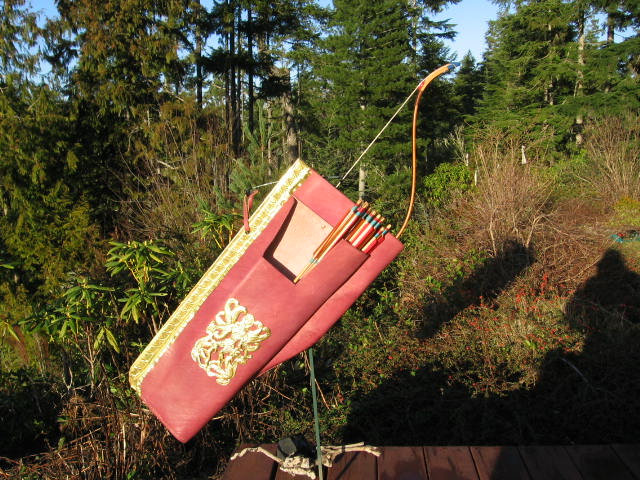Difference between revisions of "Arion the Wanderer"
Amandakittie (talk | contribs) m |
|||
| Line 18: | Line 18: | ||
[[category:people]] | [[category:people]] | ||
| + | [[Category:OGGS]] | ||
Revision as of 03:48, 8 September 2011
Here's some photos of Arts and Sciences projects I have made.
A Scythian Gorytos, circa 400 BC. The Scythians were nomadic horsemen who ranged across the Eurasian steppe. The were know for their very small, but powerful composite bows. Much of what we know of the Scythians comes from burial mounds that have been locked in permafrost and ice for the last 2,000 - 3,000 years and Herodotus' History. 
A Turkish Siper. Ottoman Empire. Used with tiny flight arrows and a Turkish composite flight bow in flight shooting contests. The goal is to shoot arrows further than anyone else. The Turks in the Ottoman Empire achieved around 900 yards with this specialized equipment.

A Urness-style wood carving. The Vikings inhabited Scandinavia between the 9th and 11th centuries. Their art developed through a series of styles during this time: · Oseberg: Chubby gripping beasts and intertwining ribbon-shaped animals with round eyes. The bodies are filled with geometric designs. · Borre: Gripping beasts loose body volume and become more ribbon-shaped. The eyes are round. The bodies are filled with geometric designs. New elements include nose, head and tail lappets and spiral hip joints. · Jellinge: The emphasis on gripping is greatly reduced. The ribbon-shaped animal’s bodies are filled with geometric designs. Lappets and spiral hip joints are used. Both round and oval eyes are used. · Mammen: Ribbon-shaped animals with more substantial bodies have round eyes and spiral hip joints. The lappets are developed into foliate patterns. The tendency to fill the body with geometric patterns is reduced. · Ringerike: More naturalistic great beasts with elaborate foliate lappets dominate. Spiral hip joints continue to be used. Geometric patterns filling the body disappear. The eyes become almond-shaped. · Urnes: Great beasts with gently curving bodies, spiral hip joints and almond-shaped eyes. Lappets are greatly reduced. Foliate elements continue as separate vegetal elements and lesser beasts. Wood carving tools used during the Viking era were quite similar to modern ones. The Urnes style carving I did was modeled after one found on the portal of a stave church in Norway. The modifications I did retain the essential elements of the original.
